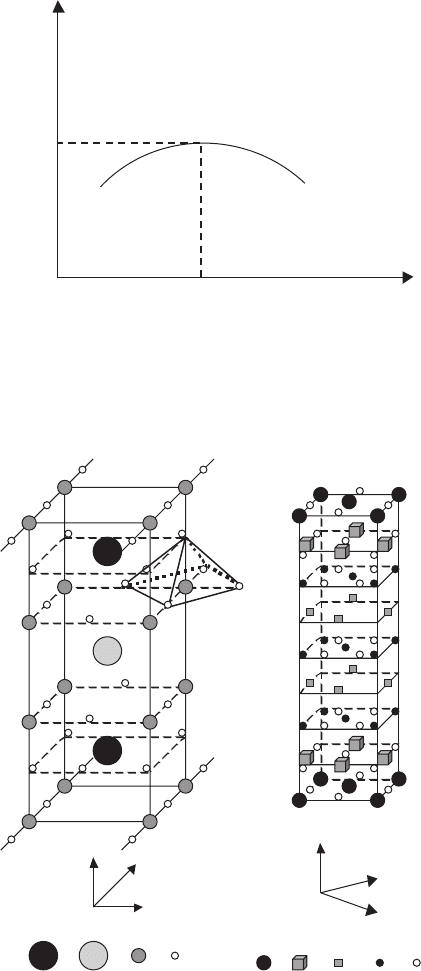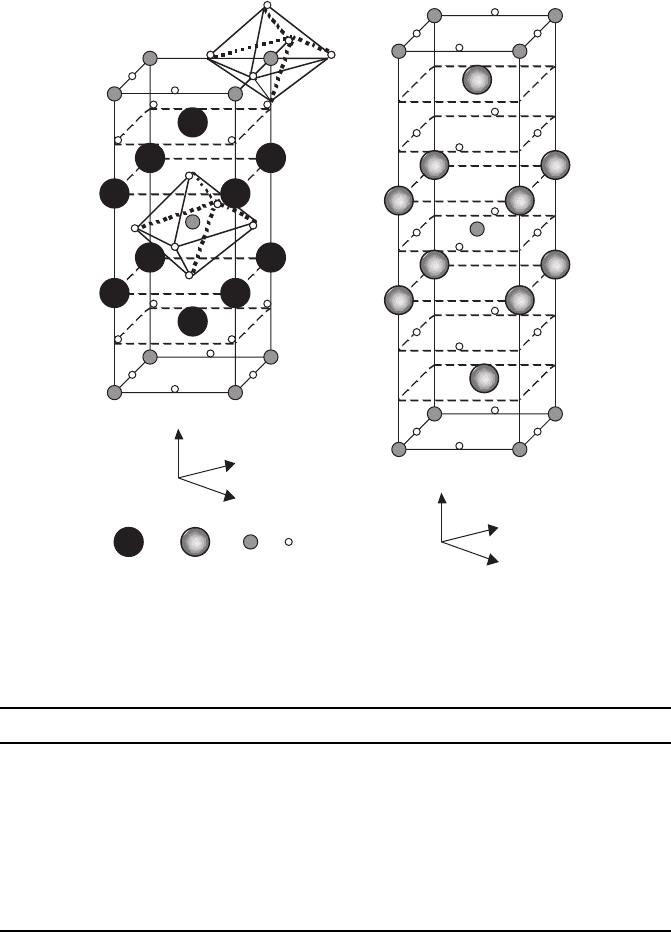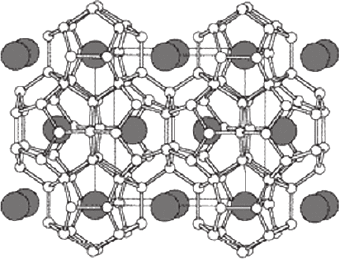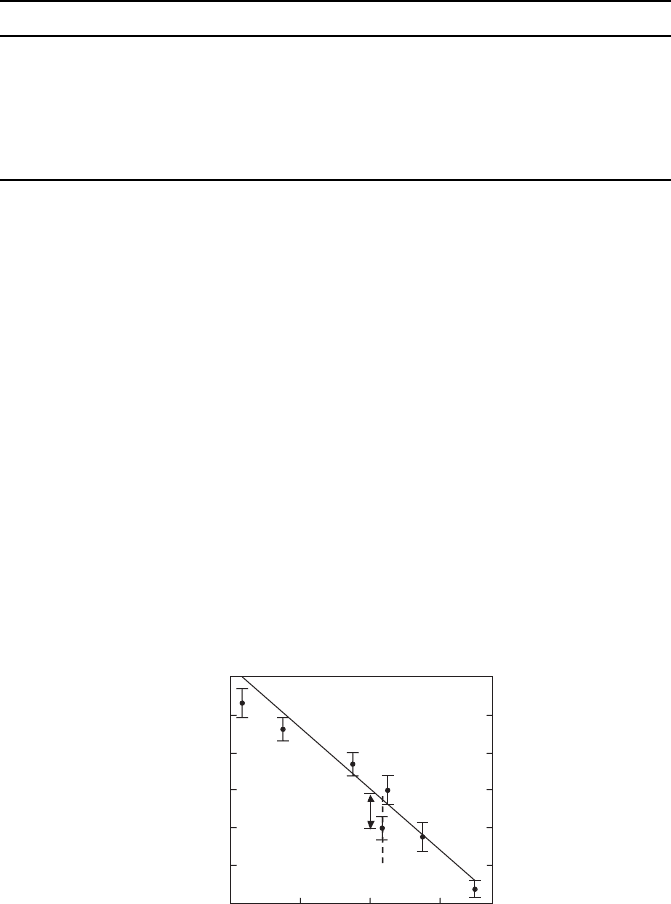Parinov I.A. Microstructure and Properties of High-Temperature Superconductors
Подождите немного. Документ загружается.

A.7 Rutheno-Cuprates 493
A.6 Pyrochlore Oxides
The superconductors with the structure of pyrochlore oxide has general for-
mula AOs
2
O
6
,whereA=Cs(T
c
=3.3K),Rb(T
c
=6.3K)andK(T
c
=9.6K).
However, these compounds with the same chemical formula differ sharply in
their superconducting properties. If RbOs
2
O
6
is the BCS superconductor [95,
529], then KOs
2
O
6
similar to HTSC relates to oxides of transitional metals,
but does not crystallize in the perovskite structure. KOs
2
O
6
crystallizes in
the pyrochlore oxide structure, based on triangle lattice, which is a classic
example of frustration effect in spin system, forming numerous spin struc-
tures [1175]. Generally, pyrochlore oxides present a great group of titan-,
tantalum- and niobium-containing minerals with cubic crystals and general
formula A
2
B
2
O
6
O
,whereA is the large cation, B is the smaller cation (usu-
ally 5d-transitional metal, i.e., Re, Os or Ir). First, superconductivity in this
oxide class has been discovered in Cd
2
Re
2
O
7
compound (T
c
= 1 K) [386]. The
difference between Cd
2
Re
2
O
7
and KOs
2
O
6
is in the number of d-electrons in
B-cation. It is interesting that KOs
2
O
6
compound with fractional degree of
oxidation has the critical temperature 10 times higher than Cd
2
Re
2
O
7
,pos-
sessing even number of 5d-electrons. In the compounds with the same struc-
ture like RbOs
2
O
6
[1176] and CsOs
2
O
6
[1174], Os ion has fractional degree of
oxidation, +5.5, disposing in intermediate state between 5d
2
and 5d
3
.Inthis
case, the 5d-electrons of Os define transport and magnetic properties of these
materials, simultaneously, a coupling of which in these oxide compounds is
mostly interesting.
The effect of high pressure (up to 10 GPa) on superconductivity in the
AOs
2
O
6
compounds has been studied for A = Cs, Rb and K [750]. The
critical temperature for all three materials increased together with pressure
up to a maximum value of T
c
=7.6K (at 6GPa), T
c
=8.2K (at 2GPa)
and T
c
=10K(at0.6GPa)forA = Cs, Rb and K, respectively, after that it
diminishes down to total disappearance at 7 and 6 GPa for A =RbandK,
and above 10 for A =Cs.
A.7 Rutheno-Cuprates
Sr
2
RuO
4
compound (T
c
∼ 1 K) is the single example of layered perovskite
without cooper, demonstrating superconductivity. This compound relates to
the class of “self-doped” conductors due to small ratio, U/W (where U is the
energy of Coulomb repulsion and W is the width of Brillouin’s zone), that is,
there the role of electron correlation is not important compared to cuprates
[654]. p-type of pairing (spin-triplet) in Sr
2
RuO
4
is realized. This system is
also called the system with ladder structure. If to seek number of legs of the
ladders per cell to infinity, then a transition to two-dimensional structure
occurs. In cuprate HTSC, the ladder role could be played by stripes, then, a
total analogy between cuprate and ruthenium systems is possible.
494 A Classification of Superconductors
Triple perovskite (“hybrid” rutheno-cuprate superconductor) RuSr
2
GdCu
2
O
8
consists of both “superconducting” CuO
2
layers and “ferromag-
netic” RuO
2
layers. Herein, superconductivity co-exists with electronic ferro-
magnetism in microscopic scale (the temperature of ferromagnetic ordering
135 K and T
c
= 50 K) [683]. The investigations of the magnetization and
magnetic resistance of the RuSr
2
GdCu
2
O
8
have demonstrated influence of
the magnetic moments of Ru atoms on the electrons of conductivity.
The intragrain critical temperature, T
c
, of HTCS cuprate RuSr
2
(Gd, Ce)
2
Cu
2
O
10+d
has been studied depending on hole concentration (which
is found by oxygen content) [1153]. In this case, T
c
changed in very wide
limits (17–40 K) with the change of p being only 0.03 holes/CuO
2
.Intothis
range of p, the intragrain superfluid density (which is inversely proportional
to square of the magnetic field penetration depth, 1/λ
2
) and the value of
the diamagnetic jump (found at the sample cooling in magnetic field) have
increased more than 10 times. These results contradict to correlations be-
tween T
c
,p and 1/λ
2
, observed in homogeneous HTSC. This is possible due
to the phase de-lamination and granularity. Moreover, there is an effect of
anomalous increasing of distance between CuO
2
planes during cooling of lay-
ered compound RuSr
2
Nd
0.9
Y
0.2
Ca
0.9
Cu
2
O
10
, doped up to level of the bound-
ary “antiferromagnetism/superconductivity” at the phase diagram [688]. This
means negative value of the thermal expansion factor. Difference in volumes
of the antiferromagnetic and superconducting phases may be caused by the
phase segregation, observed often in weakly doped HTSC.
A.8 High-Temperature Superconductors
Superconducting compound belong to HTSC, if it has one or more CuO
2
planes. The cuprates possess a perovskite, strongly anisotropic crystalline
structure, defining majority of their physical and mechanical properties. In
conventional superconductors, there are no important structural effects, be-
cause the coherence length (ξ) is much longer than the penetration depth (λ).
However, it is not the case for cuprates due to ξ<<λfor them. In general, the
high-T
c
materials are basically tetragonal (orthorhombic), and superconduc-
tivity in cuprates occurs in the copper-oxide planes. These layers are always
separated by layers of other atoms such as Bi, O, Y, Ba, La, etc., which pro-
vide the charge carriers into CuO
2
planes. In the CuO
2
planes, each copper
ion is strongly coupled to four ions, separated by a distance approximately
1.9
˚
A. At fixed doping level, by increasing the number of CuO
2
planes, T
c
first increases, reaching the maximum at n =3(wheren is the number of
CuO
2
layers per unit cell), and then decreases. So, nuclear magnetic reso-
nance (NMR) data show that the charge carriers are distributed inhomoge-
neously between CuO
2
layers (into limits of one elementary cell) in mercurial
HTSC at n>3. Their concentration into “internal” layers is smaller than into
“external” [569]. Based on the phenomenological approach, it has been shown

A.8 High-Temperature Superconductors 495
Table A.4. Transition temperature and number of CuO
2
planes for different
cuprates
No. Cuprate CuO
2
planes T
c
(K) Abbreviation
1La
2−x
Sr
x
CuO
4
138LSCO
2Nd
2−x
Ce
x
CuO
4
1 24 NCCO
3YBa
2
Cu
3
O
7−x
293YBCO
4Bi
2
Sr
2
CuO
6
1 ∼ 12 Bi-2201
5Bi
2
Sr
2
CaCu
2
O
8
2 95 Bi-2212
6(Bi, Pb)
2
Sr
2
Ca
2
Cu
3
O
10
3 110 Bi-2223
7Tl
2
Ba
2
CuO
6
1 95 Tl-2201
8Tl
2
Ba
2
CaCu
2
O
8
2 105 Tl-2212
9Tl
2
Ba
2
Ca
2
Cu
3
O
10
3 125 Tl-2223
10 TlBa
2
Ca
2
Cu
4
O
11
3 128 Tl-1224
11 HgBa
2
CuO
4
1 98 Hg-1201
12 HgBa
2
CaCu
2
O
6
2 128 Hg-1212
13 HgBa
2
Ca
2
Cu
3
O
8
3 135 Hg-1223
14 HgBa
2
Ca
3
Cu
4
O
10
4 123 Hg-1234
15 HgBa
2
Ca
4
Cu
5
O
12
5 110 Hg-1245
[133] that due to lower concentration of carriers into “internal” layers of the
multilayered elementary cell, a value of pseudogap in these layers is large and
superconducting order is suppressed, therefore the following increasing of n
does not lead to growth of T
c
.
The critical temperature and the number of the CuO
2
planes are presented
for different HTSC in Table A.4. In most superconducting cuprates, by chang-
ing the doping level at fixed n,theT
c
(p) dependence has the bell-like shape,
where p is the hole concentration in CuO
2
planes (see Fig. A.4). This shape
of T
c
(x) dependence is more or less universal in cuprates, where x can be
p, n, the lattice constants a, b or c, the buckling angle of CuO
2
layers, etc.
Thus, the maximum T
c
value can be only be attained when all the required
parameters have their optimum values.
In the HTSC also, as in conventional compounds, there is a change in va-
lency due to the change in electron–phonon interaction. The oxygen content
defines the transition temperature. As an example, the transition tempera-
ture, T
c
, as a function of x and δ for the system Bi
2
Sr
2
Ca
1−x
Y
x
Cu
2
O
8+δ
is
presented in Table A.5. Crystal structures of high-temperature superconduc-
tors LSCO, YBCO, Bi-2212 and NCCO are shown in Fig. A.5.
Search for superconductors with high values of T
c
is continuing. Table A.6
shows a variety of superconducting cuprates, differing in their structural and
chemical properties, discovered beginning from 1986. These superconductors
are grouped in compositional principle.
The partial substitution of Y by Ca, and Ba by La in YBa
2
Cu
4
O
8
does
not have an influence in practice on T
c
. At the same time, the substitution
of Cu by Zn or Ni leads to rapid degradation of superconductivity [1144].

496 A Classification of Superconductors
T
c
T
c, max
Optimum Value Parameter
Fig. A.4. Critical temperature as a function of a parameter, which can be the
doping level, the number of CuO
2
planes per unit cell, the unit-cell constants, the
buckling angle of CuO
2
layers, etc
Ba Sr
(a) (b)
b
a
c
c
b
a
Y-123
Bi-2223
Y Cu O Bi Ca Cu O
Fig. A.5. Crystal structures of HTSC: (a) YBCO and (b) Bi-2223, (c) LSCO, and
(d) NCCO (continued)

A.8 High-Temperature Superconductors 497
La, Sr
O
(c) (d)
b
a
c
c
b
a
LSCO NCCO
Nd, Ce
Cu
Fig. A.5. (continued)
Table A.5. Composition and oxygen content dependence of critical temperature in
the system Bi
2
Sr
2
Ca
1−x
Y
x
Cu
2
O
8+δ
[986]
No. xδ Cu-valency T
c
(K)
1 0.0 0.23 2.23 70
2 0.1 0.23 2.18 90
3 0.3 0.30 2.15 86
4 0.35 0.30 2.12 74
5 0.4 0.29 2.09 64
6 0.5 0.33 2.08 40
7 0.75 0.41 2.03 < 4
8 1.0 0.51 2.01 < 4
498 A Classification of Superconductors
This result agrees totally with two-dimensional picture, in accordance of which
high-temperature superconductivity is caused by pairing into CuO
2
layers. If
intactness of these layers is violated (as in the case of substitution of the copper
atoms), then T
c
decreases. If atomic disorder arises outside these layers (as in
the case of substitution of the yttrium and barium atoms), then T
c
does not
change.
High-temperature superconductivity in thin films [70] and in monocrystals
[1207] of PrBa
2
Cu
3
O
x
has been discovered in 1996. The value of T
c
=56.5K
at P =0inPrBa
2
Cu
3
O
x
monocrystal (x =6.6) increases up to 105 K
at P =9.3 GPa [1170, 1208]. This result contrasts sharply with data for
YBa
2
Cu
3
O
x
, in which the value of T
c
∼ 90 K at x =(6.8–7) is almost in-
dependent of P up to P = 10 GPa. Obviously, the different responses of
PrBa
2
Cu
3
O
x
and YBa
2
Cu
3
O
x
on high pressure is connected with various
characters of distribution of the charge carriers between structure units of el-
ementary cell, and with different re-distribution of the charge under pressure,
respectively. The value of T
c
≈ 90 K has been attained in the polycrystalline
PrBa
2
Cu
3
O
7−d
samples [26]. Most probable cause of superconductivity in
PrBa
2
Cu
3
O
7−d
is the partial substitution of Pr by Ba [760].
HTSC NdBa
2
Cu
3
O
x
(Nd-123) holds set of records among RE-123 (T
c
∼
95 K, high irreversible line, etc.). The main advantages of Nd-123 consists
in anomalous peak effect, leading to significant increasing of intragrain cur-
rents for account of formation of the effective pinning centers, which begin
to work at liquid nitrogen temperature in magnetic field of some Tesla, that
are most interesting for HTSC technical applications. Only in Nd-123, it is
possible to attain the results, using chemical methods, which are comparable
in effect to cumbersome, expensive and difficult-accessible methods of phys-
ical formation of the pinning centers (e.g., due to neutron irradiation or ion
bombardment). Additional advantages of the Nd-123 phase are also connected
with its higher chemical stability and higher rate of solidification. New pin-
ning centers into Nd-123 are formed during de-lamination of re-saturated solid
solution [425, 747]. In this case, the sites of solid solutions form in the basic
superconducting matrix. These sites are distributed homogeneously in the
matrix and are coupled coherently with it, because they act as effective pin-
ning centers in the external magnetic field. In the case of non-zero magnetic
field, superconductivity in them is suppressed sharply, causing the peak effect.
Due to these new pinning types, the irreversibility line in the Nd-123 samples
displaces magnetic fields above 8 T at 77 K (the record value for RE-123 su-
perconductors). Moreover, Nd and Ba can exchange places in the Nd-system
due to favor combination of the ionic radii that forms the defects, serving
strong pinning centers. Majority of HTSC have p-type of superconductivity
(YBa
2
Cu
3
O
7
, La
2−x
Sr
x
CuO
4
, Bi
2
Sr
2
CaCu
2
O
8
,etc.).Nd
2−x
Ce
x
CuO
4
is the
most studied of no numerous HTSC with n-type conductivity. Note that an-
tiferromagnetism is the main alternative to superconductivity as in electronic
HTSC also as in hole-doped superconductors [510].
The structure of “infinite-layer” ACuO
2
(where A is the alkaline-earth
metal) compounds presents a set of parallel CuO
2
layers, separated by the

A.8 High-Temperature Superconductors 499
Table A.6. Superconducting cuprates discovered from 1986
YBa
2
Cu
3
O
7
+ RE equivalents Sr
1−x
CuO
2
(Y, Pr)Ba
2
Cu
3
O
7
(Ca, Sr, La, Nd)CuO
2
(Y, Ca) Ba
2
(Cu, Zn)
3
O
7
(Ca, Na, Sr, K)
2
CuO
2
Cl
2
(Sm, Nd)Ba
2
[Cu
1−y
(Ni, Zn)
y
]
3
O
7
(Sr, K)
3
Cu
2
O
4
Cl
2
TbSr
2
(Cu, Mo)
3
O
7
(Cu, CO
2
)(Ba, Sr)CuO
3+δ
YBa
2
Cu
4
O
8
+ RE equivalents (Cu, CO
2
)(Ba, Sr)CaCu
2
O
5+δ
Y
2
Ba
4
Cu
7
O
15
(Cu, CO
2
)(Ba, Sr)Ca
2
Cu
3
O
7+δ
Bi
2
(Sr, La)
2
CuO
6
(Cu, X)Sr
2
(Y, Ca)Cu
2
O
7
,
Bi
2+z
Sr
2−x−z
La
x
CuO
y
where X =Pb, CO
2
, SO
3
, BO
3
,
Bi
2
Sr
2
CaCu
2
O
8
Bi, Mo
Bi
2
Sr
2
Ca
2
Cu
3
O
10
+(Bi, Pb) equivalents GaSr
2
(Y, Ca)Cu
2
O
7
Bi
2
Sr
2
Ca
2
Cu
3
O
8
F
4
NbSr
2
(Nd, Ce)
2
Cu
2
O
10
Tl
2
(Ba, La)
2
CuO
6
(Nd, Pr, Sm) CeCuO
Tl
2
Ba
2
CaCu
2
O
8
(La, Pr, Nd)
2−x
Ce
x
CuO
4−y
Tl
2
Ba
2
Ca
2
Cu
3
O
10
Sr
2
CuO
3
F
x
Tl(Ba, La)
2
CuO
5
Nd
2
CuO
4−d
F
δ
TlBa
2
CaCu
2
O
7
(La, Ba, Nd, Ce, Sr)
2
CuO
4
(Tl
0.5
, Pb
0.5
)Sr
2
(Ca, Y)Cu
2
O
7
(La,RE)
2
CuO
4
,whereRE =Y,Lu,
Sm, Eu, Gd, Tb
(Tl
0.5
Pb
0.5
)(CaSr
2−x
)(La
x
Cu
2
)O
7
(Tl
0.5
Sn
0.5
)Ba
2
(Ca
0.5
Tm
0.5
)Cu
2
O
x
(La, Sr)
2
CaCu
2
O
6
TlBa
2
Ca
2
Cu
3
O
9
+(Tl, Pb)Sr equiva-
lents
(Eu, Ce)
2
(Eu, Sr)
2
Cu
3
O
9
(Cu, Tl)Ba
2
Ca
2
Cu
3
O
y
[CaCu
2
O
3
]
4
TlO
x
(CO
3
)
y
(Sr, Ca)
n+1
Cu
n
O
z
(Cu
0,5
Cr
0,5
)Sr
2
Ca
n−1
Cu
n
O
2n+3+d
(X, Cu)(Eu, Ce)
2
(Eu, Sr)
2
Cu
2
O
8
,CaBa
2
Ca
2
Cu
3
O
9−δ
X =Pb,Ga CuBa
2
Ca
3
Cu
4
O
12−d
Hg(Ba, La)
2
CuO
4+δ
(Sr, Ca)
14
Cu
24
O
41
HgBa
2
CaCu
2
O
6+δ
Pb
2
(Sr, La)
2
Cu
2
O
6
HgBa
2
Ca
2
Cu
3
O
8+δ
PbSr
2
(La, Ca)Cu
3
O
8
HgBa
2
Ca
2
Cu
3
O
8+δ
F
x
Ba
2
RE(Ru, Cu)O
6
,whereRE =Y,Pr
(Hg, Re)Ba
2
Ca
2
Cu
3
O
8+δ
Sr
2
RE(Ru, Cu)O
6
,whereRE =Y,Pr
HgBa
2
Ca
3
Cu
4
O
10+δ
RuSr
2
RECu
2
O
8
,whereRE =Eu,
HgBa
2
Ca
4
Cu
5
O
12+δ
Gd, Y
Hg
2
Ba
2
CaCu
2
O
7+δ
RuSr
2
(Nd, Y, Gd, Ca, Ce)
2
Cu
2
O
10
layers of the A atoms. They are simplest (in structure and chemical compo-
sition) copper-oxide superconductors and have no structure blocks, playing
the role of the charge reservoirs. Due to this reason, they are ideal candi-
dates for research of basic characteristics of CuO
2
plane, which is the main
structure unit of copper-oxide HTSC. The critical temperature, T
c
∼ 60 K,
has been attained in CaCuO
2
monolayers, surrounded from both sides by
500 A Classification of Superconductors
Ba
0.9
Nd
0.1
CuO
2+x
layers, which carried out a function of the electric charge
reservoirs. In this case, the measured “one-layer” critical current density,
J
c
> 10
8
A/cm
2
at T =4.2 K [46].
The irreversibility line in the infinite-layer copper-oxide electronic HTSC
Sr
0.9
La
0.1
CuO
2
samples without admixtures, synthesized under high pressure,
disposed much more higher than in La
1.85
Sr
0.15
CuO
4
and Nd
1.85
Ce
0.15
CuO
4
[504]. The critical current density was also much more higher that proposed
strong pinning of magnetic flux. Moreover, it has been stated that super-
conductivity of Sr
0.9
La
0.1
CuO
2
is three-dimensional in contrast to quasi-two-
dimensional superconductivity of all HTSC cuprates [544].
A.9 Rare-Earth Borocarbides
The rare-earth borocarbide LuNi
2
B
2
C has critical temperature, T
c
, approxi-
mately 16 K, at the same time, LuNiBC is not superconducting. The super-
conductor is obtained, adding carbon in Lu plane. On the other hand, LuNiBC
is obtained from LuNi
2
B
2
C, adding the other layer of Lu–C. Thus, the super-
conducting composition is fabricated from isolator by changing corresponding
atom ratio. Similarly in La
2−x
Sr
x
CuO
4
, superconducting phase is formed from
isolating phase by changing parameter x [737]. The compounds ReNi
2
B
2
C
with Re = Y, Lu, Tm, Er, Ho and Dy are superconducting with moderate
high critical temperatures, T
c
≈ 16 K. At low temperatures, there is antifer-
romagnetic phase, and the phase exists in which can co-exist superconductiv-
ity and magnetic long-range order. As for the example of Ho
1−x
RE
x
Ni
2
B
2
C
(RE = Y, Lu) system with different numbers of Ho(RE)C layers, a clear cor-
relation of T
c
with the density of states in Fermi level has been found. The
various magnetic structures are derived which co-exist with superconductivity.
The highest T
c
= 23 K is attained in YPd
2
B
2
C.
A.10 Silicon-Based Superconductors
Up to recent time, only one superconducting compound of silicon family,
namely ThSi
2
with T
c
=1.56 K, has been known. However, recently, it has
been stated that semimetal CaSi
2
becomes a superconductor with T
c
=14K
at pressure P>12 GPa [919].
In contrary to known crystalline silicon structures, the various cavities can
form at slightly distorted angles between links. Clathrate crystals are the com-
pounds consisting of molecules and atoms (“guests”) into cavities of frame of
the crystalline lattice (“host”). Clathrate structures form on the base of differ-
ent matters with tetrahedron coordination of atoms. Two types of clathrates
are known, namely the silicon compounds M
x
Si
46
and M
x
Si
136
(where M =
Na, K, Rb, Cs). If part of the alkaline atoms in this “friable” (but right)

A.12 Carbon Superconductors 501
Ba
Si
Fig. A.6. Crystal structure of silicon clathrate superconductor Ba
8
Si
46
[1163]
clathrate structure of the silicon compound M
x
Si
46
(where M = Na, K) is sub-
stituted by Ba, then this structure becomes superconducting [522]. Clathrates
Na
2
Ba
6
Si
46
and Ba
8
Si
46
have critical temperatures, T
c
= 4 K [522] and 8 K
[1163], respectively. Crystal structure of Ba
8
Si
46
is presented in Fig. A.6.
A.11 Chalcogens
Superconductivity of sulphur with T
c
= 10 K arises under P =93GPa,at
P = 200 GPa, the value of T
c
attains a maximum of 17.3 K, and at further
increasing of the pressure again decreases down to 15 K. The similar depen-
dences of T
c
(P ) are observed in Se and Te. For example, the superconducting
transition takes place in Se at T
c
=(4−6) K in the range of P =15−25 GPa,
while T
c
=8KatP>150 GPa [342].
The superconducting composites C/S, fabricated from press-powders of
graphite and sulphur (23 wt%), which are synthesized in argon, have demon-
strated T
c
= 35 K (the superconducting transition has been found by Meiss-
ner’s effect) [170]. In this case, the magnetization curves demonstrated
hysteresis that is proper for type-II superconductors.
The controlled intercalation of copper into di-chalcogen TiSe
2
leads to
initiation of the waves of charge density (WCD), which are periodical modu-
lations of the density of conductive electrons, and also to arising of supercon-
ductivity at the copper content x =0.04 in calculation per formal unit [731].
The maximum T
c
=4.15 K has been observed at x =0.08. Thus, a correlation
of WCD with superconductivity could be studied in the example of Cu
x
TiSe
2
.
A.12 Carbon Superconductors
One of the forms of carbon has 60 atoms per molecule, C
60
.Alargenumberof
molecules can be made using C
60
. The compounds A
3
C
60
are superconducting
and their properties are given in Table A.7. The doping by electrons reaches

502 A Classification of Superconductors
Table A.7. The critical temperatures and the lattice constant of the f. c. c. unit
cell [986]
No. Formula a
0
(
˚
A) T
c
(K)
1Rb
2
CsC
60
14.493 31.3
2Rb
3
C
60
14.436 29.4
3Rb
2
KC
60
14.364 26.4
4Rb
1.5
K
1.5
C
60
14.341 22.15
5RbK
2
C
60
14.299 21.8
6K
3
C
60
14.253 19.28
the critical temperature of 33 K in the system Rb
y
Cs
x
C
60
[1049]. The highest
T
c
= 40 K has been obtained in Cs
x
C
60
[792]. If there are defects in the lattice,
ln T
c
varies as the inverse square of the unit cell constant (see Fig. A.7).
Nature of high-T
c
of fullerenes is not understood totally. Herein, significant
help could be rendered by experimental definition of the power, α,fromthe
isotopic effect T
c
∼ M
−α
,where M is the mass of atoms. In [296],
12
C has been
substituted practically totally (on 99%) by isotope
13
CinRb
3
C
60
monocrys-
tals with T
c
= 31 K and has been found the value of power α =0.21 ± 0.012.
Based on these calculations, it is concluded that the phonon mechanism of
electron pairing with “intermediate” force of electron–phonon interaction is
realized in the doped fullerenes.
Then, an existence of Meissner’s effect (repulsion of magnetic field from
volume of superconductor) in the polycrystalline copper-containing fullerides
(fullerene-containing crystallitecompounds) at temperatures up to 110 K has
been experimentally stated [869]. The estimation of the experimental data
showed that approximately thousandth part of the bulk sample has supercon-
ducting properties, causing the repulsion force.
3.5
3.4
3.3
3.2
3.1
3.0
2.9
4.85
δT
c
Rb
2
CsC
60
Rb
3
C
60
Rb
2
KC
60
Rb
2
KC
60
RbK
2
C
60
K
3
C
60
Rb
1.5
K
1.5
C
60
ln T
c
4.90 (×10)
−3
4.75 4.80
1/a
0
(Å
–2
)
2
Fig. A.7. The dependence of ln T
c
vs inverse square of the unit-cell constant [986]
